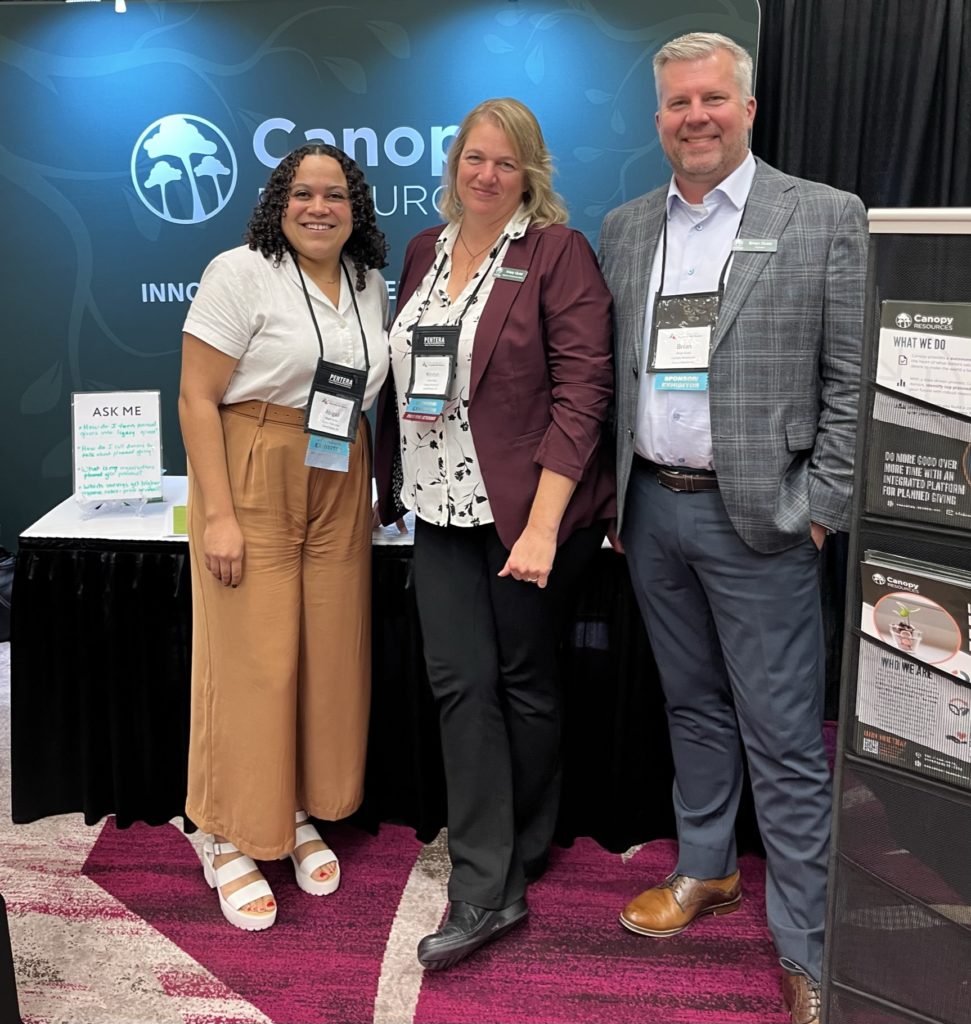6 Takeaways from the 2022 CGP Conference

Last week hundreds of nonprofit professionals gathered in Reno for the annual CGP Conference presented by the National Association of Charitable Gift Planners. The Canopy team was among them! Staying informed about current planned giving trends is important to us, and this year’s conference gave us a glimpse into the future of planned giving. It was hard to condense three very info-packed days into this short list, but we walked away with 6 things that we think every development professional needs to know going into 2023.
- This feels like a fresh start. There was a palpable eagerness to “get going again.” We heard lots of talk about implementing new initiatives, revising strategic plans, hiring additional staff, expanding upon existing programs, and even cleaning up donor data. After what has felt like a couple years of chaos, it seems as though the upcoming year might be spent getting back to regularly scheduled programming.
- Diversity continues to be a focus, both internally and externally. Some sessions focused in on DEI efforts to include more diverse donors, like Trina Olidge (Georgia Institute of Technology), who spoke on the intricacies and nuances of high-net-worth donors of color. We also learned what nonprofit professionals can be doing internally to attract and retain more diverse teams of professionals. Abigail Oduol (Earthjustice) led a session and panel discussion about DEI in action, including several real-life examples of implementation and Earthjustice’s white paper on DEI. It became clear that focusing on diversity and inclusion can help you achieve your goals, both for the advancement of your organization and for the wellbeing of your team.
- Charitable planned giving remains a worthy investment of time, money, and capacity. The stakes are high and the ROI is unmatched. Many presenters reminded us that we are in the midst of a large wealth transfer, and with that wealth transfer comes an opportunity for charitable organizations to earn their place in a donor’s plans. Planned gifts are often larger than all other gifts (yes, even those huge annual gifts from top-tier donors), and it’s in your organization’s best interests to focus on understanding why donors choose to support the mission with this unique type of gift. Some sessions focused on how to kickstart a planned giving initiative, while other focused on specific giving vehicles. It seemed like no matter where nonprofit professionals are in the process of the planned giving journey, CGP had a session to help.
- Cash isn’t always king. Multiple speakers warned against falling into the trap of cash-only gifts. So what are the real moneymakers? Non-cash assets. Real estate, retirement assets, and even cryptocurrency all made the list for types of assets that could be included in a donor’s plans aside from cash. Dr. Russell James III and Bryan Clontz reminded us in the closing session that the majority of high-net-worth donors’ wealth is in assets as opposed to cash, so it’s valuable to have a basic understanding of wealth management as it relates to charitable gifts.
- HNW and UHNW donors have different charitable giving needs. Nonprofit professionals are adding two more acronyms to their lexicon: High-net-worth donors (HNW donors) and ultra-high-net-worth donors (UHNW donors). These terms were revisited in the closing sessions, but I heard the words sprinkled throughout other sessions as well. Most HNW donors require creative solutions when it comes to their wealth management. Many are looking for ways to support their favorite missions and make smart decisions for their money. Development professionals need to be asking the right questions to best understand the most valuable options for donors, and most of the time those questions are asking about passion rather than money.
- What’s the right time to talk about planned giving? It might be sooner than you think. In one memorable session, data showed that family conversations about wealth, especially for HNW and UHNW donors, are trending earlier than in previous years. Donors that skew slightly younger are willing to part with more of their wealth earlier, as long as it’s not too risky for their family’s needs and the needs of their heirs. Canopy has demonstrated this fact with our nonprofit partners by uncovering hidden major donors, regardless of age, through our automated dialogue process. This information presents a new question to consider: is your organization creating space for legacy donors who might not fit the traditional mold?
If you’re heading into end-of-year giving season (and the EOY hangover that follows in January) without a strategy for planned giving, Canopy is here to help. We have everything you need to turn your annual donors into legacy givers, while keeping an eye on the trends to maximize your efforts. Get in touch today to get started.
